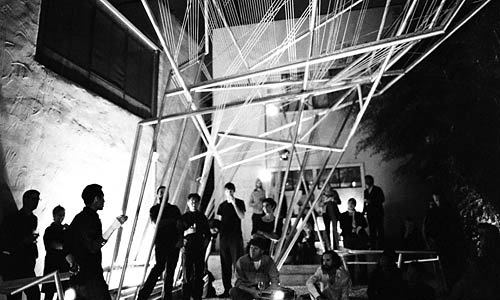“Where should I put the test tubes?” asked one confused chef’s assistant. It’s not a question normally heard at a dinner party, but then again, Materials & Applications—the landscape/architecture research center in Silver Lake where the bash was being held—doesn’t do “normal.” And that includes this retro-futuristic-themed dinner celebrating the 50th anniversary of the Russian satellite Sputnik, where the test tubes were used for vodka shots.
Run by Jenna Didier, 38, and Oliver Hess, 35, M&A is fast becoming a hot spot on the art party circuit, thanks to events the couple hosts in conjunction with the architectural marvels installed twice yearly in their 1,000-square-foot courtyard. “We have an open-door policy for new ideas, whether it’s food or architecture,” said Didier, who founded the space in 2002 and has since lived there with Hess. “[It’s about] fostering an avant-garde spirit without the elitist tendencies of the avant-garde. The more fun the idea, the more we’re interested in trying to pull it off.”
The idea for last month’s Sputnik soiree began when German artist Francis Hunger invited Didier and Hess to participate in an international Sputnik Day with other creative types around the world (the couple connected with Hunger through a mutual friend). The timing was perfect, as M&A’s nearly completed installation, “Density Fields”—an “extreme cantilever” by Dwayne Oyler and Jenny Wu made of aluminum and polypropylene rope—could provide the perfect far-out backdrop for a party.
To feed their guests, Didier and Hess called on friend Joshua Gil, a former chef de cuisine at Joe’s in Venice, to create an out-of-this-world dinner—literally. Gil had been tweaking the restaurant’s comfort food with freezing and gelling techniques associated with a culinary movement dubbed “molecular cuisine,” so he was ready to experiment for the Commie-chic festivities. The result? A menu that used traditional Russian ingredients such as beets, turnips, horseradish, caviar and vodka, but also played with ideas of Space Age food such as bacon powder and orange dust.
As partygoers arrived—among them, ecological designer Freya Bardell and Mark Allen of Echo Park’s Machine Project gallery—Gil and his assistants were putting the finishing touches on the feast: making “caviar” pearls from apples, frying tiny sticks of potatoes that would be served with an oyster panna cotta, carbonating vodka and blueberries.
Meanwhile, Didier taught her lab coat-clad volunteers how to make the perfect Moscow Mule, a cocktail with ginger ale, lime juice and vodka (“the real stuff, Stolichnaya”). Straight chilled vodka also was available at the bar, which featured a dangling half-size Sputnik model fashioned out of a stainless-steel garden ball and metal tomato stakes. “See you in space!” Didier said, raising her glass. She explained that Russian astronauts used to toast one another and do shots before taking off. “I wish I knew how to say it in Russian.”
The meal kicked off with a “not-so-bloody Mary,” a white gazpacho of tomato essence and Marcona almond sorbet topped with a single pickled tomato and spiked with tiny gelled capsules of horseradish, chives and vodka that burst on the tongue. After glancing around self-consciously, most guests licked the tiny bowls clean. That starter set the bar high, but the borscht-braised short ribs with horseradish crème fraîche that followed didn’t disappoint. The meat was succulent, practically melting off its little toothpick tripods in the shape of Sputnik. “I could eat a whole tray,” raved Beth Reiter, who reps cinematographers, editors and production designers in the film industry. “Is there more coming out?” She appeared genuinely crestfallen after learning that she had missed an opportunity for seconds while chatting inside.
But more delights kept coming: a single poached Gulf shrimp with truffled turnip and hot sea urchin aioli, a tiny parfait of silky oyster panna cotta topped with potatoes that finished with a zing of arugula pesto and lemon gastrique.
As it turned out, the haute cuisine was just part of the experience. Didier and Hess, along with friend Marcos Lutyens (the trio develops interactive projects under the banner Infranatural), had been talking for years about a “sensory restaurant,” where sound, sight and feel are as integral as taste to the dining process. They decided to give the idea a whirl at the Sputnik party. Every so often, Hess headed into a room just off the courtyard to help Lutyens conduct “experiments.” As diners consumed plates of food, the pair played different noises in their ears, including the sound of wind blowing through grass and the familiar beeping of Sputnik’s transmissions. “Did you find that the sounds enhanced the food or dimensionalized it?” Lutyens asked Bardell, the ecological designer, who was given a plate of toasted quinoa, sautéed cabbage and pork belly (the vegetarian stayed away from the meat). “The high-pitched sound sort of changed the flavor sensation,” Bardell said.
As the night wore on, the courtyard got crowded. “This is a great excuse to dork out and enjoy technology,” said Tenzin Phuntsog, an artist and filmmaker who brought space-themed films for after-dinner viewing. He also used Skype to communicate with other Sputnik parties and was projecting celebrations from Budapest to Leipzig. Nearby, Oyler and Wu obsessed over their installation (“Look at those ropes slacking!” Oyler said). And industrial designer Eddy Sykes confessed to nabbing “about eight” of the homemade verbena marshmallows. As Phuntsog cued up a Sputnik documentary, Didier thanked guests for coming and led a round of applause for chef Gil. She then brought out a special guest, Renata Raksha, an artist and true-blue Russian who gave one last toast: “Uvidemsya v kosmosye!” she said. Translation: “See you in space!”



